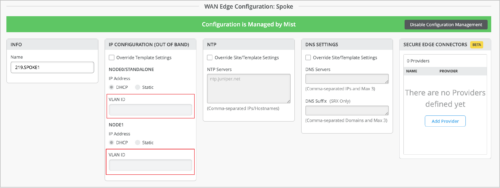
Help us improve your experience.
Let us know what you think.
Do you have time for a two-minute survey?

Help us improve your experience.
Let us know what you think.
Do you have time for a two-minute survey?
Solutions
Featured solutions AI Campus and branch Data center WAN Security Service provider Cloud operator Industries
Welcome to the NOW Way to Wi-Fi
Take your networking performance to new heights with a modern, cloud-native, AI-Native architecture. Only Juniper can help you unleash the full potential of Wi-Fi 7 with our AI-Native platform for innovation.

AI Data Center Networking
Juniper’s AI data center solution is a quick way to deploy high performing AI training and inference networks that are the most flexible to design and easiest to manage with limited IT resources.

Enterprise AI‑Native Routing
Juniper's Ai-Native routing solution delivers robust 400GbE and 800GbE capabilities for unmatched performance, reliability, and sustainability at scale.

Ops4AI Lab
Visit our lab in Sunnyvale, CA and see our AI data center solution for yourself. You can try out your own model’s functionality and performance, too.

Enterprise AI‑Native Routing
Juniper's Ai-Native routing solution delivers robust 400GbE and 800GbE capabilities for unmatched performance, reliability, and sustainability at scale.

Shaping Student Experiences: The NOW Way to Build Higher Education Networks
Juniper Networks CIO Sharon Mandell and a virtual summit of C-level IT leaders from prestigious institutions discuss ongoing efforts to support digital transformation on campus.

Security in healthcare
In this IDC Spotlight report, discover how AI networking can automate and strengthen a healthcare ecosystem to defeat criminals and prevent loss.

The Future of In-Store Technologies
Retail experts Kevin McCartan, Senior IT Service Delivery Engineer at Musgrave; Jack Stratten of Insider Trends; and Christian Gilby, Senior Director of Product Marketing at Juniper Networks, discuss customer experiences.
Products
Wireless access Wired access SD-WAN / SASE Routing and switching Security Mist AI™ Management software Network operating system Blueprint for AI-Native Acceleration Optics
Juniper ACX7020 Cloud Metro Access Router
Legacy networks simply cannot meet the demands of today’s rapidly evolving metro landscape. Unlock a new generation of highly scalable architectures and automated operations with the Juniper ACX7020.

Next-gen AI-Native EX4000 line of switches
Lack of AI innovation from your current networking vendor slowing you down? Embrace Juniper’s cloud-native, AI-Native access switches that support every level and layer, across nearly every deployment.

The Q&AI Podcast
Delivering practical solutions and enriching discussions, this podcast series is a vital resource for those seeking an in-depth exploration of AI's transformative potential.
Services
Services
Juniper AI Care Services Revolutionize Your Service Experience
Our industry-first AI-Native services couple AIOps with our deep expertise across the full network life cycle. You can move from reactive response to proactive insight and action.

Juniper AI Data Center Deployment Services Optimize Your AI Model Runs
We use our expertise and validated designs to help design, deploy, validate and tune networks, including GPUs and storage, to get the most from your AI infrastructure operation.
Partners
PartnersSupport and Documentation
Support and Documentation
The Juniper Support Portal (JSP) mobile app is now available!
Get Juniper support anytime, anywhere with the JSP mobile application, now available for Android and iOS!
Learn
About Juniper Training Events The Feed Resources Technology learning topics Thought leadership and insights
Executive insights
Dive deep with leading experts and thought leaders on all the topics that matter most to your business, from AI to network security to driving rapid, relevant transformation for your business.

Leadership voices
Juniper Networks’ leaders operate on the front lines of creating the network of the future. Take a look around to see what’s on their minds.

Bob Friday Talks
Join Bob as he ventures into all the knowns -- and -- unknowns -- of AI.
date_range 01-Sep-23
The webhook configuration in the organization and site settings has received a facelift. Webhooks enable you to receive real-time updates from Mist on a variety of topics that include alerts, device up and down information, and audit logs. You can now configure multiple webhooks with different topics or destinations. You also have an option to configure the Splunk webhook format. Splunk is a platform used for collecting, indexing, and analyzing data. You can configure the Splunk webhook by selecting Splunk from the Webhook Type drop-down list on the Webhooks tile on the Organization > Settings or Organization > Site Configuration > site namepage. The Splunk webhook type does not support custom headers. The default webhook type in Mist is ‘HTTP POST’.
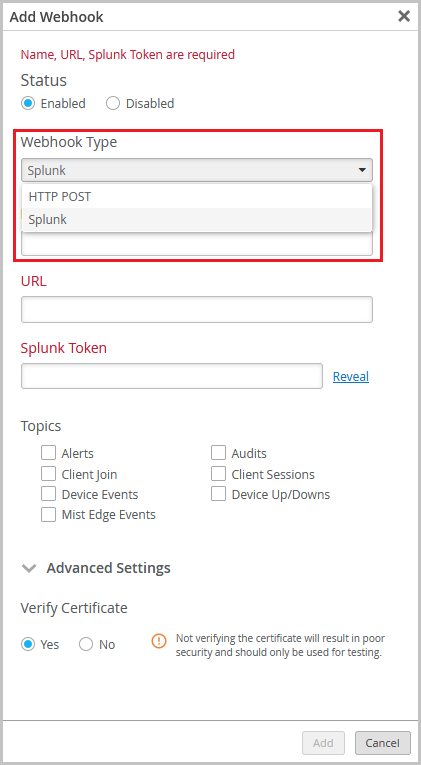 zoom_out_map
zoom_out_mapYou can now import site variables to Mist in a CSV file. You can import the site variables from the Site Variables tile on the site configuration page (Organizations > Site Configuration > site name).
 zoom_out_map
zoom_out_mapIf any variables in the CSV file conflict with the existing site variables during the upload operation, Mist discards them. Only new variables are uploaded.
You can use one of the following methods to upload the site variables:
Download the current site variable list in a CSV file from the Import Site Variables window, append new variables to the list and upload it.
Upload a completely new CSV file without the existing variables.
The CSV file must have a header row that contains the fields Variable,Value. The header row must be followed by the variable names and the values in this format:{{variableName}},someValue. See the following sample:
Variable,Value
{{ssid}},Mist Guest
{{guest_vlan}},957
The Mist portal now supports the 24-hour clock. By default, Mist maintains a 12-hour clock. If you want to switch to a 24-hour clock, select the 24-Hour Time check box from the My Account page (as shown below). The default date format is MM-DD-YYYY.
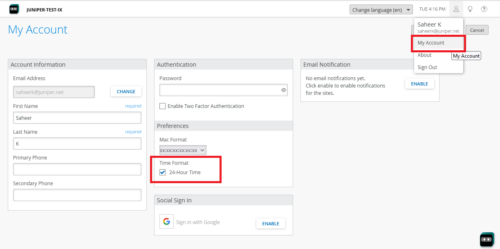 zoom_out_map
zoom_out_mapThe WAN Edge devices now support the following new LTE graphs:
LTE RSRP: Reference Signal Received Power (RSRP) represents a measure of the received power level in an LTE network. Supported range: -200 through 10 dBm.
LTE SNR: The Signal-to-Noise Ratio (SNR) graph compares the level of the received signal to the level of background noise and displays the number of dBs by which the signal is above the noise floor. Supported range: -50 through 50 dB.
You can view these graphs on the WAN Edge Insights page.
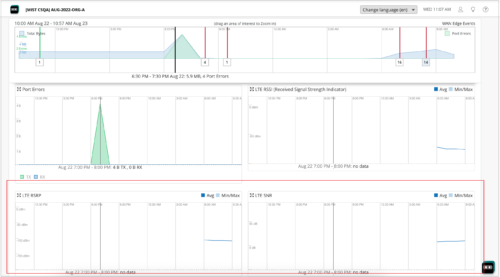 zoom_out_map
zoom_out_mapThe WAN Edge Insights page for the SRX Series devices now shows jitter, loss, and latency data for overlay links. These network performance metrics provide insights into the quality of your network connection.
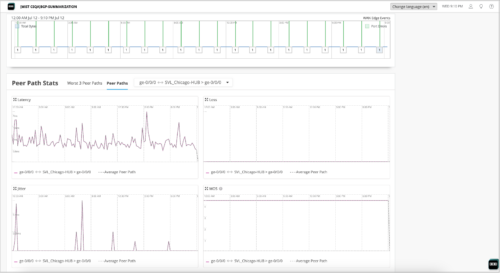 zoom_out_map
zoom_out_mapYou can configure the BGP routing policies on your WAN Edges to append a new community value to the existing community values. Previously, the only option available in the BGP policy was to completely replace any community values existing in the prefix received, using the Set Community action.
The BGP routing policy now supports the following new actions:
Append Community: Appends the specified community value to the existing communities. The Append Community and Set Community actions are mutually exclusive.
Exclude Community: Excludes the specified community. The Exclude Community and Set Community actions are mutually exclusive.
If you specify both Append and Exclude actions for the same community value, the Append action takes priority.
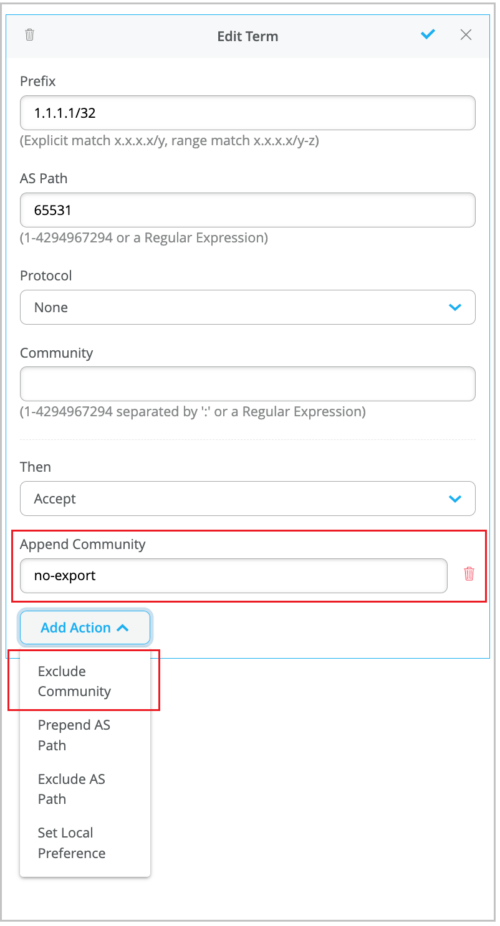 zoom_out_map
zoom_out_mapThe WAN Edges now support VLAN configuration for out of band management interfaces that use DHCP. You can configure a VLAN for the out of band management interface from the IP CONFIGURATION (OUT OF BAND) tile on the WAN Edge configuration page (WAN Edges > WAN Edges > device name). This option allows you to perform out of band management using a separate management network. Mist also places the out of band management traffic into a dedicated management virtual routing and forwarding (VRF) instance.
